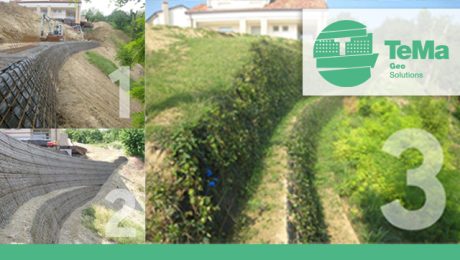‘Natural’ solutions for dry slopes with TeMa products
Environment, climate, energy, territorial planning, natural risk prevention, and water resource research and management are what researchers and planners have to deal with today in connection with environmental works. These are all ‘watchwords’ in the modern world of geotechnics, which require specific know-how and the use of suitable materials, in the awareness that the search for solutions is constantly evolving. With a proactive approach that provides geotechnical applications for soil protection, and expertise to aid the sustainable management of processes, we can now carry out the required works while making the land safe and harmonising the landscape.
Surface water shapes the soil, now more than ever before, due to the increase in extreme events. Today, there is a growing awareness that the ‘natural’ resources we have at our disposal are capable of limiting the effects of scouring and runoff. On dry slopes, for example, soil erosion is the process whereby materials are removed by the mechanical and chemical actions of wind and water. From a technical/scientific perspective, a further distinction is made: in addition to the concept of soil erosion , there is soil loss and sediment yield .
The effect of weathering on the soil is therefore a phenomenon to be foreseen and controlled. On the surface, the causes cannot always be detected, but a Geologist – after carrying out the necessary research – will pinpoint the problems and recommend solutions.
The main phenomena associated with soil depletion are:
- the thickness of arable soil, which includes organic substances, water, mineral salts and fine particles, decreases on a local scale: within a few generations, fertile soil can become arid;
- accelerated and uncontrolled surface erosion can cause landslides on steep slopes, increasing the extent and intensity of crumbling to the point of destroying the vegetation cover of an entire slope;
- eroded material is carried downhill, thereby reducing the capacity of watercourses and thus increasing the risk of flooding;
- the sedimentation of eroded material that ends up in irrigation channels decreases their efficiency and service life;
- eroded material, often laden with chemicals from agricultural practices such as fertilisers and insecticides, instead of being absorbed by the soil, becomes concentrated in watercourses, spreading pollution over a wider area.
The new design concept – determined by precise environmental choices – undoubtedly promotes sustainability. In this respect, on dry slopes, soil ‘helped’ by suitable products to encourage revegetation becomes a very strong ‘barrier’ to inclement weather over time.
By observing the grassed embankments bordering major road and railway routes, we can appreciate the need, which is met, to protect the safety of infrastructures against problems of topsoil slippage. These are artificial embankments, created to meet technical requirements. They were therefore barren at the time of construction, and hence exposed to the impact and removal of soil by rainwater. Ensuring grassing therefore increases the level of safety, improves visual impact and, last but not least, respects biological diversity that is preserved.
New TeMa Geo Solutions materials make these solutions possible. To encourage vegetation to take root, TeMa has come up with K-Mat synthetic geomats and biomats in natural fibre matting (straw, coconut and jute), ECOVERMAT and ECOVERNET, in addition to the X-Grid PET-C AMrange of geomats, which are also useful for reinforcing slopes.
TeMa, an Italian company established in 1993, has gained experience on 4 continents with products for the world of geotechnics, which are trusted by planners and contractors. Over 30 years of providing geotechnical solutions that aid the soil with its own erosion control and stabilisation potential, resulting in a clear environmental advantage.
- Published in Dry slopes, Erosion mats, GEO


